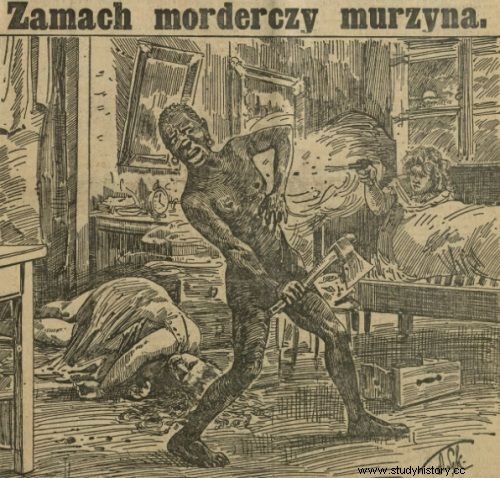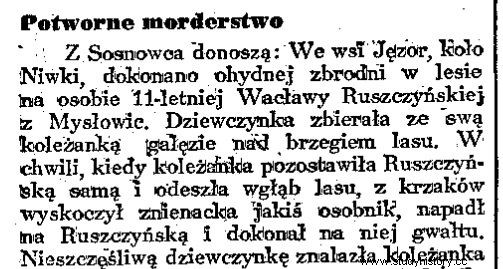b> Officially, pre-war Poles were an extremely prudish nation. No one was shocked by articles about bloody murders, spiced up with drastic descriptions and illustrated with photos of dismembered victims, but sexual crimes? People agreed that I should not write about it
As a result, only a few rapes (even those culminating in murder) aroused the interest of the press. Police statistics were also extremely understated. According to them, there were 700-900 of erotic crimes per year . Nowadays, the police record rapes themselves more than twice as many, and yet the crime rate has decreased several times since the times of the Second Polish Republic.
What, then, were the newspapers willing to write about? For example about black rapists (these are the times when no one has heard of political correctness yet!). In May 1936, Dziennik Poranny described the death of Felicja Neugerówna - a thirteen-year-old Jewish woman attending the sixth grade of a primary school in Rabka. She went missing one evening and the searches organized by the family did not produce any results.

The Negro - the villain of the pre-war press ... (photo from "Ilustrowany Kuryer Codzienny" from 1911).
At the same time, a not so rare incident took place in Rabka - all the windows in the synagogue were broken. As it turned out, the two things were closely related.
The next day, a man named Rudolf Freudlich noticed that a man had run out of his barn, behaving extremely anxiously . At Freulich's scream:"Stop!" the fugitive looked back and then Freulich recognized him as a negro - a caretaker employed in the local ritual slaughterhouse.
When he called him by name, the runaway stopped, and Freulich offered him a cigarette and asked, "Where is Neugger?" Then the Negro told that he lured the girl to the slaughterhouse, where he raped her, and then hit her in the head with a stone.
When the girl lost consciousness, he took her in his arms and threw her into the well. As the well had low lining, it also fell into the water itself, but after a while it rose to the top. The Neuggernaut went down.

A degenerate slaughterhouse caretaker in Dziennik Poranny.
Apparently, after committing the crime, the caretaker went to sleep and only in the evening experienced a sudden attack of madness, during which he demolished the synagogue, shouting: I will murder everyone! Surprisingly, this sensational story found its way to the fourth page of the newspaper, to the column "Poland in a cross-section". In addition, the "Ilustrowany Kuryer Codzienny", who was going much closer to Rabka, knew nothing about her. So maybe the amazing story has been colored by journalists? After all, a wild Negro raping innocent girls is a theme taken from novels of the time!
He jumped out unexpectedly and committed a rape
A month later, the same column reported another pedophile crime. It was carried out in a forest near the village of Jęzor near Sosnowiec. Two girls, including 11-year-old Wacława Ruszczyńska from Mysłowice, went there for wood.
At the moment when my friend left Ruszczyńska alone and went into the forest, an individual jumped out of the bushes, attacked Ruszczyńska and raped her. The unhappy girl was found by a friend who was unconscious and immediately notified Ruszczyńska's parents, because the victim of the degenerate did not have the strength to go home .
The raped girl was left completely alone in the middle of the forest for several hours. When her parents finally got there, all they found was a dead body hanging from a tree branch. The rapist took advantage of the fact that the victim was left unattended and killed her to cover up all traces. Perhaps he was counting on the family believing in the suicide of the battered Wacława. In any case, the perpetrator could not be caught.
Characteristically, nearly all of the stories reported in the press were about children - almost never adult women. Before the war, one might get the impression that rape was only a threat until the age of eighteen. In reality, of course, this was not the case, but the tight corset kept women from reporting such crimes and keeping journalists from writing about them.

Rozalia Pałkówna. A victim of a "sexual murder" whose photo was published in "Illustrated News" in 1921.
He cut his throat because she was breaking away
In 1928, "Ilustrowany Kuryer Codzienny" reported on an attempted rape of 14-year-old Eliza Filipsówna. The incident took place in Warsaw at Grochowska Street in the evening. An unknown man accosted the girl and started a conversation with her. Apparently, Eliza forgot not to talk to strangers and allowed herself to be led into the cage of one of the houses on the aforementioned street.
There a man: tried to enslave her. The girl defended herself with the last of her strength and finally managed to get away. Then the furious thug pulled out a knife and cut the girl's throat. (...) The bloody girl, swaying on her legs, ran towards the Gocławski Canal, trying to commit suicide. She was lucky in a misfortune, because the Chief of Police was just passing through the street. He immediately called an ambulance, which took Eliza to the Transfiguration Hospital. The girl survived, the perpetrator was not caught.
A teenager who was found in horrible condition in one of Żnin's streets in July 1936 also survived. She was lying in a pool of blood, showing no signs of life - wrote "Dziennik Poranny". She was immediately taken to hospital, where she regained consciousness after a few hours. She told police that she was attacked by several individuals who first raped her repeatedly and then severely beaten her. The girl was mutilated for life. The newspaper did not inform whether the perpetrators were caught.

Ruthless, decisive and deadly. The most famous criminals of pre-war Poland in the book by Kamil Janicki "Fallen ladies of the Second Republic". Buy with a discount on empik.com.
Girls raped, burglaries and cyanide
The case of Stefan Piech, who was not only a pedophile and rapist, but also an efficient burglar, also echoed. The heinous deeds he had committed with underage girls were only discovered because his leg was off during one of the robberies. In October 1924, the police surrounded him in a building on the Main Square in Krakow, and Piech - seeing no way out - bit a cyanide capsule. At first, the officers did not know who they were dealing with. The man had the documents of a teacher named Zalewski with him, so this was exactly what the press was about. It was only in February of the following year that the true identity of the suicide burglar came to light:
In fact, his name was Stefan Piech and he was one of the most dangerous burglars operating on Krakow's pavement. Piech forged official papers, which he had stolen from the teacher Zalewski, and on the basis of these he obtained a teaching position in Postugów in Greater Poland. (...) As a "teacher", from 1920-22 he committed a series of rapes of underage girls.
It was only when the school management demanded that the false master's degree show the results of the qualifying examination that he fled to Krakow. There - in the end - the degenerate individual judged himself.

"Monstrous Murder." The case of Wacława Ruszczyńska in the daily Dziennik Poranny.
Such, seemingly sensational, story deserved only the sixth page in the widely read "Ikac" ("Illustrated Daily Kuryer"). A much louder crime took place in Lviv ten years later. It was an unusual matter, as the victim fell victim to an adult woman, and as a rule, these were not written about. Nevertheless, the killer made such an effort that the newspapers simply could not downplay his actions. We once published an article devoted to him. However, the story of little Zosia from Łódź and her degenerate mother echoed the most - you can read about her in the book "Fallen ladies of the Second Republic of Poland".
Sources:
The article is based on source materials and literature collected during the work on the book "Upadłe damy II Rzeczpospolitej".
Buy the book (much) cheaper than others:
